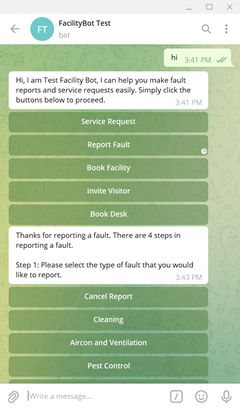FMTech Insights: Why Messaging should be at the Heart of Smart Facilities Management

FMTech Insights is a series where subject matter experts and thought leaders in FMTech share their knowledge and opinions on the topic of their expertise; helping the industry learn, innovate and grow. The series will cover every sector in FM – from workplace management, operations and maintenance, energy management, waste management and everything in between.
Patrick Sim is the Co-founder and Director at FacilityBot, the messaging-first CMMS that allows requestors (building users and FM teams alike) to use their preferred messaging app instead of calling a hotline to report faults, requests for services, requests for desks (hot desking), book common facilities, and many others.
Why Messaging should be at the Heart of Smart Facilities Management
In recent years, terms such as Smart Cities, Smart Buildings and Smart Facilities Management have become popular. These terms evoke visions of artificial intelligence, data analytics, physical robots, ubiquitous sensors, video analytics, automated energy optimization and fully automated workflows, amongst others. On the ground the reality is quite different, with voice calls, paper checklists, excel files and manual processes still prevalent.
How do we get from today’s ground reality to the vision of Smart Facilities Management?
This article contends that messaging should be at the heart, and indeed the starting point, of efforts towards this vision.
What is the goal of Facilities Management?
Ask different facilities managers this question and it is likely that you will receive a variety of answers. Some replies might focus on ensuring equipment uptime. Others might focus on ensuring contract renewal by providing great service to the building owner.
While these are legitimate daily pre-occupations of facilities management, in many cases, there is a lack of focus on building occupants. Whether it is preventive maintenance to make sure chiller systems do not fail, or repairing room lighting; ultimately, the goal is for people in the building to live or work productively and comfortably.
It is time to refocus on building occupants as the ultimate beneficiaries of facilities management systems and put building occupants back in their rightful place, which is at the heart of smart facilities management efforts.
Currently, most interactions between building occupants and facilities managers occur over voice calls. This analogue form of communication is inherently inefficient and creates a divide that impedes automation and deep engagement. It is time to bring building occupants into the same digital ecosystem with facilities managers.
The best way to do so is to support communication channels that building occupants prefer. In our daily lives, most of us have already switched to messaging apps as our primary way of communication. It, therefore, follows that facilities management systems should also support this “messaging-first” approach.
Automated Messaging
Facility managers who today entertain messaging as a mode of communication are generally doing this on an informal and manual basis using personal accounts, an approach that is clearly not ideal.
A much better approach is for the Computerized Maintenance Management System (“CMMS”) to integrate directly with popular messaging apps such as WhatsApp, Telegram, Facebook Messenger, Facebook Workplace, Line, Google Chat, Slack and Teams.
Building occupants can message fault reports or service requests directly into the CMMS and receive automated responses and updates. Systems that automatically respond to messages are considered “chatbots”. Supporting this natural mode of communication with building occupants also brings benefits for smart facilities management.
- Since messaging is digital in nature, the fault reporting and service request process flow becomes digital from end-to-end.
- Data can be seamlessly collected -- there is no need for the hotline operator to enter data into a system.
- Response times can be accurately measured -- there is no lag between when the fault is reported and when it is entered into the system.
- Task assignment can be automated -- based on configurable workflow rules, tasks can be automatically assigned to the appropriate responder based on location, priority or fault type.
- Response times can be reduced --the reduction of the data entry lag and assignment lag will result in faster response times.
- Other digital features, such as language translation, can be easily implemented.
Bringing Building Occupants into the Digital Ecosystem
To bring building occupants into the digital ecosystem, various options are available, including using mobile apps and installed hardware devices. Messaging is the most generic and flexible way to do so. Building occupants have the freedom to enter any text or image they wish. Buttons within the messaging apps can be easily configured to be shown to the building occupants, depending on the services being offered.

In this way, facilities managers can decide from a whole range of services that they want to offer such as fault reporting, booking rooms, inviting visitors, booking desks and requesting for soft services of all types, such as food ordering and event management, through that single communication channel. Each building can easily configure the text and button replies to suit its particular context.
Of course, communication should not be one-way. Facility managers would be able to send broadcast messages and surveys to building occupants. Individual responders can chat with building occupants to resolve their specific fault report.
Once within the messaging digital ecosystem, building occupants’ sentiment can even be automatically measured through artificial-intelligence powered “Automated Sentiment Analysis”.
Messaging before IoT Sensors
Any discussion about Smart Facilities Management should involve a discussion of how IoT sensors can automatically alert and trigger responses by facilities managers. For example, a faulty piece of equipment can automatically report downtime to facilities managers.
However, before considering installing a myriad of sensors in a building, would it not make sense to allow digital reporting by humans first? After all, humans are the best “sensors” to report issues of all types, including defects that require visual inspection, objects such as furniture not connected to the internet and also issues that are subjective, such as comfort levels.
Once the messaging connection is in place between building occupants and facilities managers, supporting IoT sensors is a natural progression since IoT sensors generally also send “messages” to a system, albeit in a codified format.
Data Collection before Artificial Intelligence
With regard to the implementation of artificial intelligence, it should generally be considered only after the implementation of the messaging connection and the installation of IoT sensors. This is because the collection of relevant proprietary data is the starting point in the development of any proprietary artificial intelligence model.
Such data is most often collected through digital fault reporting, digital checklists and IoT sensors. Discussions of implementations of artificial intelligence for smart facilities management, such as for predictive maintenance, often overlook the need to first collect relevant proprietary data to develop and train the models.
Messaging should be the first step towards Smart Facilities Management
As the facilities management industry moves inexorably towards the vision of Smart Facilities Management and Smart Buildings as building blocks for Smart Cities; it is important to consider what steps to take to arrive at this vision.
Messaging is not only easy and relatively cheap to implement, but it can also serve as the backbone on which other initiatives, such as IoT integration and artificial intelligence, are built.
As the Chinese saying goes, “A journey of a thousand miles begins with a single step”.

